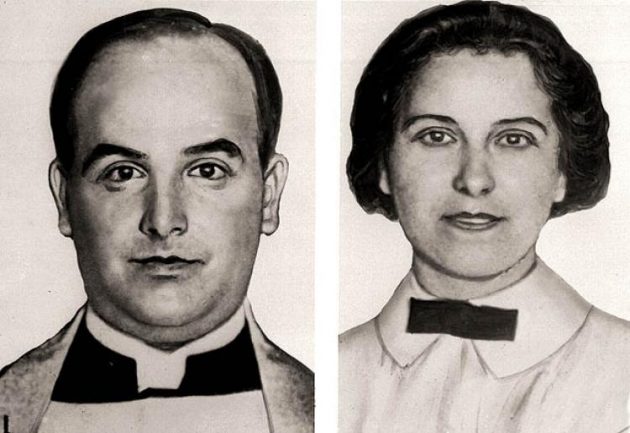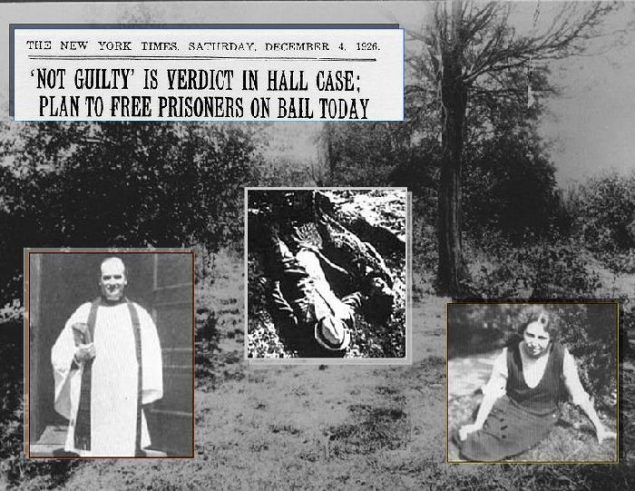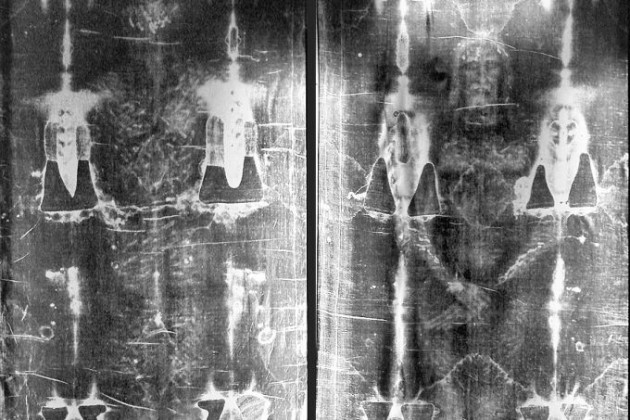The Hall–Mills murder case involved an Episcopal priest and a member of his choir with whom he was having an affair, who were murdered on September 14, 1922, in Somerset, New Jersey. The suspected murderers, the priest’s wife and her brothers, were acquitted in a 1926 trial. In the history of journalism, the case is largely remembered for the vast extent of newspaper coverage it received nationwide; it has been regarded as an example of a media circus. It would take the Lindbergh kidnapping trial in the 1930s to eclipse the high profile of the Hall-Mills murder

The Hall–Mills murder case involved Edward Hall, an Episcopal priest and Eleanor Mills, a member of his choir with whom he was having an affair.
Edward Hall and Eleanor Mills were murdered on September 14, 1922, in Somerset, New Jersey. The suspected murderers, the priest’s wife and her brothers, were eventually acquitted in a very strange trial in 1926.
The case, being both strange and horrific, created immense media coverage and public interest.
The discover of a murder
On September 16, 1922, the bodies of a woman (Eleanor Mills) and a man (Edward Hall) were discovered on their backs in a field, both shot in the head with a .32-calibre pistol, the man once and the woman three times. The bullet entered the man’s head over his right ear and exited through the back of his neck. The woman was shot under the right eye, over the right temple and over the right ear. A police officer at the scene noticed that the woman’s throat had been severed, and maggots were already in the wound, indicating the death occurred at least 24 hours earlier.
The bodies appeared to have been positioned side by side after death. Both had their feet pointing toward a crab apple tree. The man had a hat covering his face, and his calling card was placed at his feet. Torn up love letters were placed between the bodies.
Initial confusion was created because the crime scene was near the Middlesex County and Somerset County border. New Brunswick (Middlesex County) police arrived first, but the crime scene was actually in Franklin Township (Somerset County). Curiosity-seekers trampled the scene and took souvenirs as the jurisdictional issue was being settled. Evidence was severely compromised, including Hall’s calling card’s being passed among the crowd.
The woman was identified as Eleanor Reinhardt Mills (born 1888), the wife of James E. Mills (1878–1965). She was wearing a blue dress with red polka dots, black silk stockings, and brown shoes. She had worn a blue velvet hat that was on the ground near her body, and her brown silk scarf was wrapped around her throat. Her arm had a bruise, and there was a tiny cut on her lip. Her left hand had been positioned, after death, to touch the man’s right thigh. An autopsy four years later showed that her tongue had been cut out.
The man was identified as Edward Wheeler Hall (born 1881), a New Brunswick Episcopal priest. He was found with his right arm positioned, after death, to touch the woman’s neck. His hat covered his face, which concealed the gunshot wound to his head. He wore a pair of glasses. There was a small bruise on the tip of his ear, and abrasions were found on his left little finger and right index finger. A wound was found five inches (127 mm) below his kneecap on the calf of his right leg. His watch was missing, and there were coins in his pocket.

The investigation
The suspects were Hall’s wife, Frances Noel Stevens (1874–1942), and her two brothers, Henry Hewgill Stevens (1869–1939) and William “Willie” Carpender Stevens (1872–1942). The original 1922 investigation by Joseph E. Stricker (?–1926) yielded no indictments. Continued speculation in the New York Daily Mirror, fueled by comments made by a man associated with one of Mrs. Hall’s housekeepers, led the then New Jersey governor A. Harry Moore to order a second investigation and a trial in 1926.
This time, Henry de la Bruyere Carpender, a cousin of the brothers, was also named as a suspect but was cleared before the main trial of the original suspects.
The Trial
The trial began on November 3, 1926, in the Somerset County Courthouse in Somerville, New Jersey, with Charles W. Parker and Frank Cleary presiding as judges. It lasted about 30 days. It garnered huge national attention, largely because of the social status of the wealthy Stevens and Carpender families. The prosecuting attorney was Alexander Simpson. Defense attorneys were Robert H. McCarter (a former New Jersey Attorney General) and Timothy N. Pfeiffer. Joseph A. Faurot was the testifying fingerprint expert. Raymond C. Stryker was the foreman of the jury.
The prosecution’s key witness was Jane Gibson, a pig farmer on whose property the bodies were discovered. The defense portrayed her as an uneducated and “crazy” woman and attempted to ruin her credibility. Gibson’s account varied, differing when told to the police, to newspapers, and at the trial (at which she testified from a hospital bed rolled into the court room). Frances Stevens Hall and her two brothers had the motive and the means for the murder, but there was not enough evidence to convict them.
Originally posted 2016-12-16 13:29:25. Republished by Blog Post Promoter













